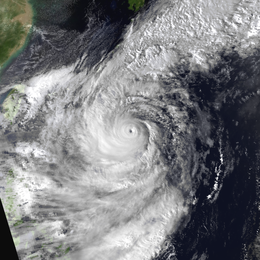| Revision as of 12:23, 24 August 2020 editJavaHurricane (talk | contribs)Account creators, Extended confirmed users, New page reviewers, Pending changes reviewers, Rollbackers22,513 editsm Reverted edits by Chicdat (talk) to last version by 台風14号Tags: Removed redirect Rollback← Previous edit | Revision as of 13:23, 24 August 2020 edit undoOnel5969 (talk | contribs)Autopatrolled, Extended confirmed users, Page movers, New page reviewers, Pending changes reviewers, Rollbackers936,687 edits Adding short description: "1984 Pacific storm" (Shortdesc helper)Next edit → | ||
| Line 1: | Line 1: | ||
| {{short description|1984 Pacific storm}} | |||
| {{Infobox Hurricane | {{Infobox Hurricane | ||
| | name = Super Typhoon Vanessa (Toyang) | | name = Super Typhoon Vanessa (Toyang) | ||
Revision as of 13:23, 24 August 2020
1984 Pacific storm| Violent typhoon (JMA scale) | |
|---|---|
| Category 5 super typhoon (SSHWS) | |
 Vanessa (28 Oct) Vanessa (28 Oct) | |
| Formed | October 22, 1984 |
| Dissipated | October 30, 1984 |
| Highest winds | 10-minute sustained: 220 km/h (140 mph) 1-minute sustained: 305 km/h (190 mph) |
| Lowest pressure | 880 hPa (mbar); 25.99 inHg |
| Fatalities | 63 total |
| Damage | $1.7 million (USD) |
| Areas affected | Caroline Islands, Mariana Islands and Philippines |
| Part of the 1984 Pacific typhoon season | |
Super Typhoon Vanessa, known in the Philippines as Typhoon Toyang was a Super typhoon that formed in October 1984. Vanessa was the strongest storm of 1984 Pacific typhoon season.
Meteorological history
| Typhoon | Season | Pressure | ||
|---|---|---|---|---|
| hPa | inHg | |||
| 1 | Tip | 1979 | 870 | 25.7 |
| 2 | June | 1975 | 875 | 25.8 |
| Nora | 1973 | |||
| 4 | Forrest | 1983 | 876 | 25.9 |
| 5 | Ida | 1958 | 877 | 25.9 |
| 6 | Rita | 1978 | 878 | 26.0 |
| 7 | Kit | 1966 | 880 | 26.0 |
| Vanessa | 1984 | |||
| 9 | Nancy | 1961 | 882 | 26.4 |
| 10 | Irma | 1971 | 884 | 26.1 |
| 11 | Nina | 1953 | 885 | 26.1 |
| Joan | 1959 | |||
| Megi | 2010 | |||
| Source: JMA Typhoon Best Track Analysis Information for the North Western Pacific Ocean. | ||||

This system formed in the near equatorial trough southeast of Ponape a few days after Thad on October 20. The system moved northwest to just north of Ponape as it slowly developed. The disturbance strengthened into a tropical depression by October 22 and a tropical storm October 23 despite some northwesterly shear from Thad. As a minimal typhoon, Vanessa moved about 165 kilometres (103 mi) south of Guam, where winds gusted to 59 knots (109 km/h) on Nimitz Hill. Damage on the island totaled US$1.7 million (1984 dollars), mainly to the banana crop. Moving west-northwest, Vanessa continued to strengthen, becoming a super typhoon. Super Typhoon Vanessa was the strongest typhoon of the season, reaching maximum sustained wind speeds of 190 miles per hour (310 km/h) over the open waters of the West Pacific. At its peak, it had a pressure of 880 mb, only 10 millibars higher than the record-setting Typhoon Tip of 1979. Its central pressure fell 100 mb in 48 hours. The intense cyclone recurved on October 27 and October 28 as a cold front approached from the northwest. Vanessa slowly merged with the frontal boundary, becoming a storm-force extratropical cyclone late on October 30.
Impact
Though the storm did not directly impact the Philippines, its outer bands triggered flooding that killed 63 people.
External links
References
- "World Tropical Cyclone Records". World Meteorological Organization. Arizona State University. Retrieved December 12, 2013.
- Japan Meteorological Agency. "RSMC Best Track Data (Text)" (TXT).
- Joint Typhoon Warning Center (1985). Super Typhoon Vanessa. Retrieved on 2007-01-13. Archived June 7, 2011, at the Wayback Machine
- Joint Typhoon Warning Center (1985). Super Typhoon Vanessa. Retrieved on 2007-01-13. Archived June 7, 2011, at the Wayback Machine
- "Destructive Typhoons 1970-2003". National Disaster Coordinating Council. November 9, 2004. Archived from the original on November 9, 2004. Retrieved April 22, 2013.